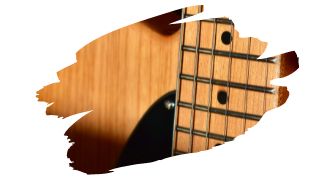Glossy maple guitar fretboards don’t exactly have the best reputation. Especially since this type of fretboard isn’t the smoothest to play, (particularly when it’s brand new).
More often than not, a high gloss fretboard needs a bit a wearing in, before you can get a truly smooth glide. Plus, the last thing you need, is to find yourself struggling to slide your fingers along that fretboard while you play.
So, in this post, you’ll find out why Maple guitar fretboards always need finishing in the first place. You’ll also learn why glossy finishes tend to feel like they have a lot of friction.
And we reveal the best way to clean a glossy maple fretboard (without the risk of removing any of it’s finish).

This post may contain affiliate links to products that we receive a commission for (at no additional cost to you). Learn more here.
Are Maple Guitar Necks Always Glossy?
Not all Maple fretboards come ‘finished’ with a high gloss coat. Some maple fretboards are left unfinished, meaning that they haven’t been sealed over with a protective coat of some sort of finish.
But, Maple wood is not a durable wood. It has no natural oils in it to protect it from drying out (unlike say a Rosewood fretboard). And this particular timber can be damaged by moisture and humidity.
So, rule of thumb, Maple fretboards are almost always sealed over to protect them. And that sealing finish can be a glossy, satin or a matte looking coat.
Related Post: Can Tru-Oil Really Finish And Protect Your Maple Fretboard?
But Are Glossy Guitar Necks Any Good?
A glossy finish will protect timber fretboards just as well as any other finish.
However, glossy finishes in particular have a touch more friction to them when you play. That is because glossy finishes don’t coat on as smoothly as a satin or matte finish.
Do You Need To Have A Finished Fretboard At All?
The need to finish and seal a fretboard depends on the durability of the wood.
Wood types that are naturally oily, (in that they have their own protective natural oils saturating their wood grain), don’t need a sealant.
That is why Rosewood and Ebony, (two very oily tropical hardwoods), are usually left unfinished as fretboards.
With these two specific wood types, their natural tree oils already safeguard them from drying out.
Maple, on the other hand, has no such natural protection from moisture. And if you leave it unsealed, this wood will dry out very quickly. Or worse, it will decay if water gets on it.
So, when it comes to Maple Fretboards, you need to seal them if you want that fretboard to last.
Related Post: Is Purpleheart Wood Good For Fretboards?
Do Maple Fretboards Get Dirty?
Play any guitar long enough, and over time, dust and dirt will begin to gather between those frets. Even the oils from your finger tips can build up too.
Related Post: Sticky Fretboard? (What To Do When Your Fretboard Feels Sticky)
So, How Do You Keep A Glossy Maple Fretboard Clean?
The best way to keep a fretboard clean, is to wipe it down with Naphtha.
This mild solvent will easily remove even the most baked in dirt. And, more importantly, it will do this without removing that gloss finish.
So, use a lint-free cloth dipped in naphtha and lightly rub away any dirt. But, be careful not to saturate your fretboard with this stuff.
Naphtha evaporates fairly quickly. However if you use too much, (and flood the fretboard), you can end up softening the finish itself.
Besides, you only need a dab of Naphtha to loosen grime enough to wipe it away.
Can You Use Acetone To Clean A Maple Fretboard? You must never use Acetone to clean a fretboard. Acetone will dissolve a glossy nitrocellulose lacquer finish.
To Wrap Up, Here Are The 3 Key Takeaways From This Post…
- 1). Glossy maple fretboards have been finished with a thin protective sealing coat.
- 2). Gloss finishes are not as smooth as Satin or Matte finishes. And this can create friction as you play.
- 3). Maple wood isn’t anywhere near as naturally durable as Rosewood fretboards. So, Maple fretboards are almost always finished.

